Volkswagen Golf SportWagen (2015 year). Instruction — part 6
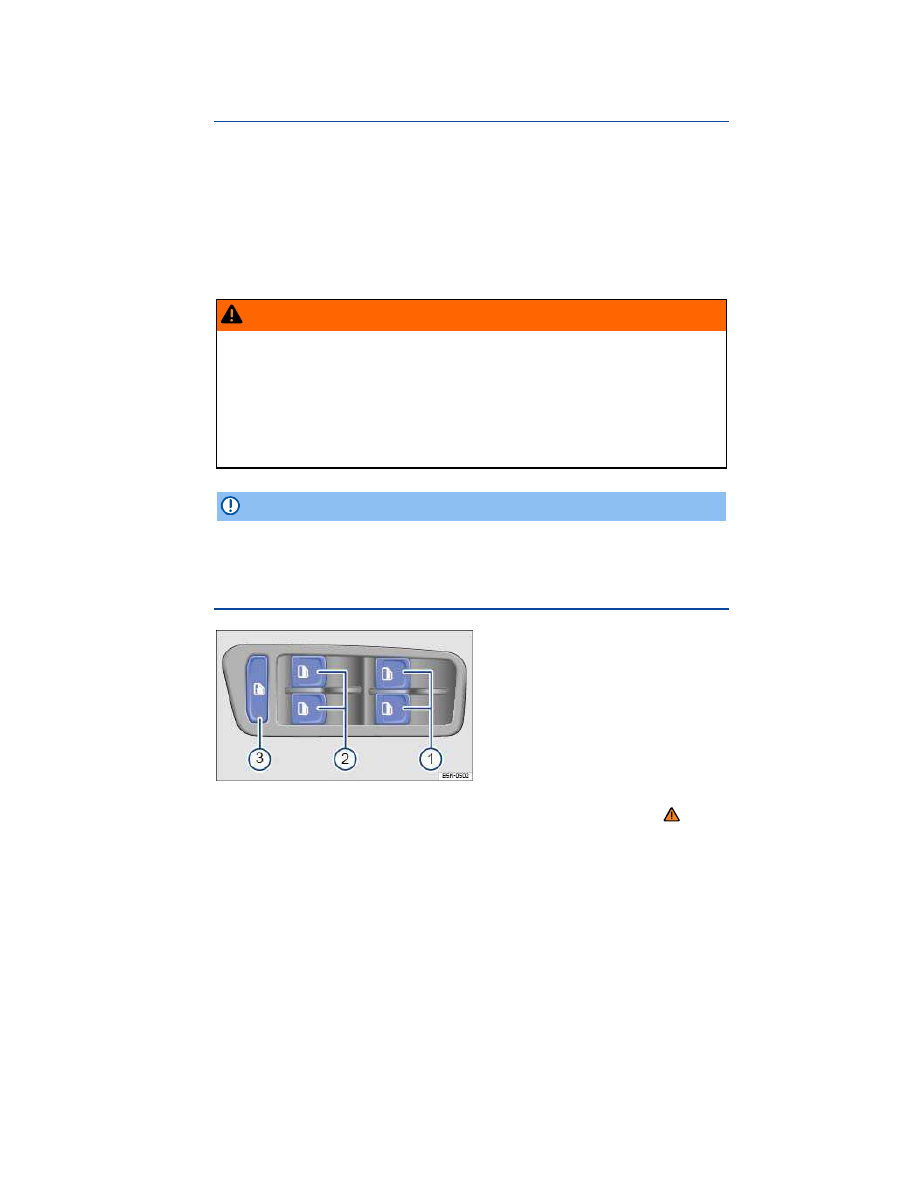
Power windows
Introduction
In this section you’ll find information about:
Opening or closing power windows
Power windows – features
Power window pinch protection
More information:
Volkswagen Information System
Infotainment system
Power locking system
WARNING
Improper use of power windows can result in serious personal injury.
Never let anyone get in the way of a power window when closing it.
When locking the vehicle from the outside, make sure that no one, especially children,
remains in the vehicle. The windows will not open in case of an emergency.
Always take the key with you when you leave the vehicle. You can still use the power win-
dows for several minutes after the ignition is switched off as long as the driver or front pas-
senger door has not been opened.
Always use the safety switch when children are in the back seat to disable the rear power
windows and keep them from being opened and closed.
NOTICE
If you leave the windows open, rain or other precipitation may enter the vehicle from outside
and can damage the vehicle interior.
Opening or closing power windows
Fig. 31 In the driver door: Switches for the front and rear power windows.
Please first read and note the introductory information and heed the WARNINGS
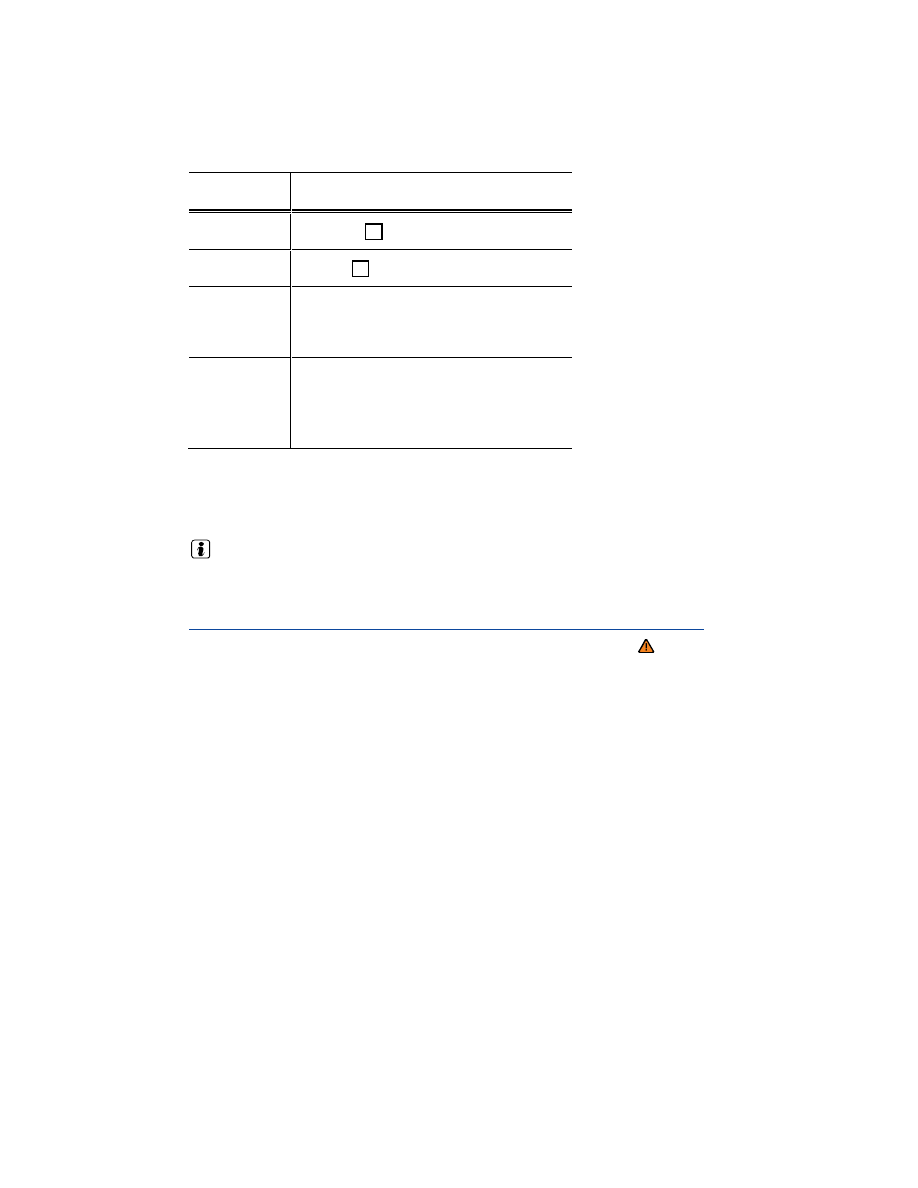
Switches in the driver door
Key to
fig. 31
:
(1)
For the windows in the front doors.
(2)
For the windows in the rear doors.
(3)
Safety switch.
Opening or closing windows
Function
Action
Opening:
Press the
switch.
Closing:
Pull the
switch.
Stopping
automatic
movement:
Press/pull the respective switch again.
The safety switch
(3)
deactivates the
power windows in the rear doors. The
yellow indicator light in the switch lights
up.
The power windows function only when the ignition is switched on.
You can still use the power windows for several minutes after the ignition is switched off as long as the
driver or front passenger door has not been opened. When the vehicle key has been removed from
the ignition and the driver door has been opened, the power windows cannot be opened or closed.
A separate switch for controlling the passenger side window is located in the front passenger
door.
Power windows – features
Please first read and note the introductory information and heed the WARNINGS
One-touch opening and closing
The one-touch feature automatically opens/closes a power window all the way. The window switch
does not have to be held down/up.
For one-touch opening: Press the switch for the window down briefly as far as it goes.
For one-touch closing: Pull the switch for the window up briefly as far as it goes.
Stopping automatic movement: Pull/press the switch again.
Reactivating the one-touch feature
If the vehicle battery is disconnected or dead and the windows are not completely closed, the one-
touch feature will not work and must be reactivated:
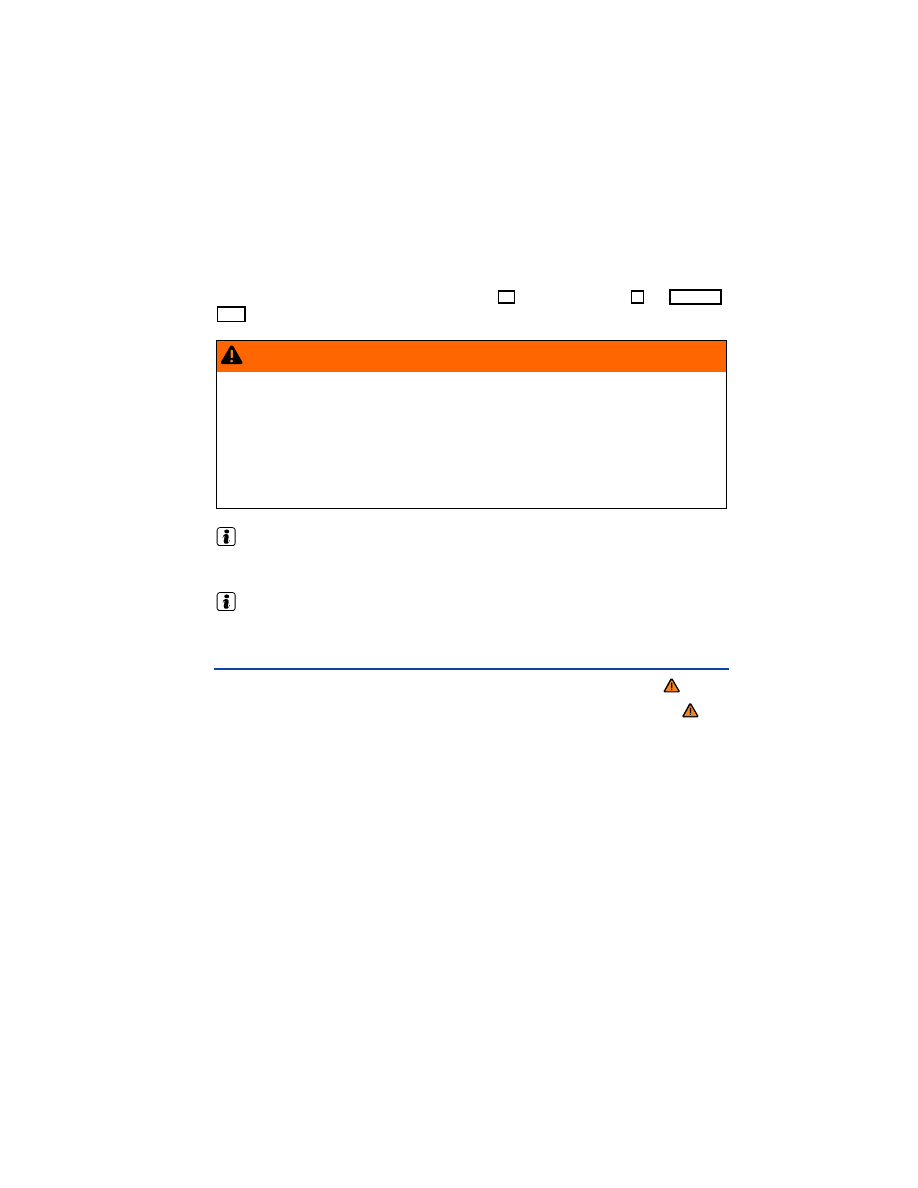
Switch on the ignition.
Close all windows and doors.
Pull the switch for the respective window up and hold it for at least 2 seconds in this position.
Release the switch, pull up and hold again. The one-touch feature is now reactivated.
The one-touch feature can be reactivated for one or more windows at the same time.
Convenience opening and closing
The convenience opening and closing feature lets you open and close the windows and the power
sunroof when the ignition is switched off:
From inside the vehicle: Push down and hold the switch for the driver window until all windows and
the sunroof open.
Vehicles with Keyless Access: Hold your finger on the lock sensor surface on the outside of the
door handle for a few seconds until the windows and power sunroof close
⇒ Unlocking or locking the
vehicle with Keyless Access.
On appropriately equipped vehicles, a variety of settings related to window operation can be made
and adjusted in the Infotainment system by pressing the
button followed by the
and Open and
close function keys
⇒ Menu and system settings (SETUP).
WARNING
Improper use of power windows can result in serious personal injury.
Never let anyone get in the way of a power window when closing it.
When locking the vehicle from the outside, make sure that no one, especially children,
remains in the vehicle. The windows will not open in case of an emergency.
Always take the key with you when you leave the vehicle. You can still use the power win-
dows for several minutes after the ignition is switched off as long as the driver or front pas-
senger door has not been opened.
Always use the safety switch when children are in the back seat to disable the rear power
windows and keep them from being opened and closed.
If the power windows malfunction, the one-touch feature, as well as pinch protection may not
work properly. See an authorized Volkswagen dealer or authorized Volkswagen Service Facility right
away.
Convenience opening and closing only works when the one-touch feature is active.
Power window pinch protection
Please first read and note the introductory information and heed the WARNINGS
Pinch protection can help reduce the risk of pinching injuries when closing a power window
⇒ . If
one-touch window closing meets resistance or there is something in the way, the window will stop and
go down again.
Check why the window did not close.
Try one-touch window closing again.
If the window meets resistance a second time, so that it stops and goes back down, one-touch
closing is deactivated for about 10 seconds.

If you pull the power window button up all the way and hold it during this 10 second interval, the
window will close without pinch protection
⇒ .
Closing the window without pinch protection
Try to close the window again within 10 seconds by holding the switch. Pinch protection is
turned off for a short distance in the window track!
If closing takes longer than about 10 seconds, pinch protection is turned on again. The window
stops again if there is resistance.
If the window still will not close, please see an authorized Volkswagen dealer or an authorized
Volkswagen Service Facility.
WARNING
Without pinch protection, power windows will close with enough force to cause serious per-
sonal injury.
Always be careful when closing power windows.
Always make sure that no one is in the way when overriding pinch protection to close
power windows!
Pinch protection cannot prevent fingers or other parts of the body from being pressed
against the window frame; injuries may result.
Pinch protection is also active during convenience closing of the windows and the power sunroof
⇒ Power windows – features.
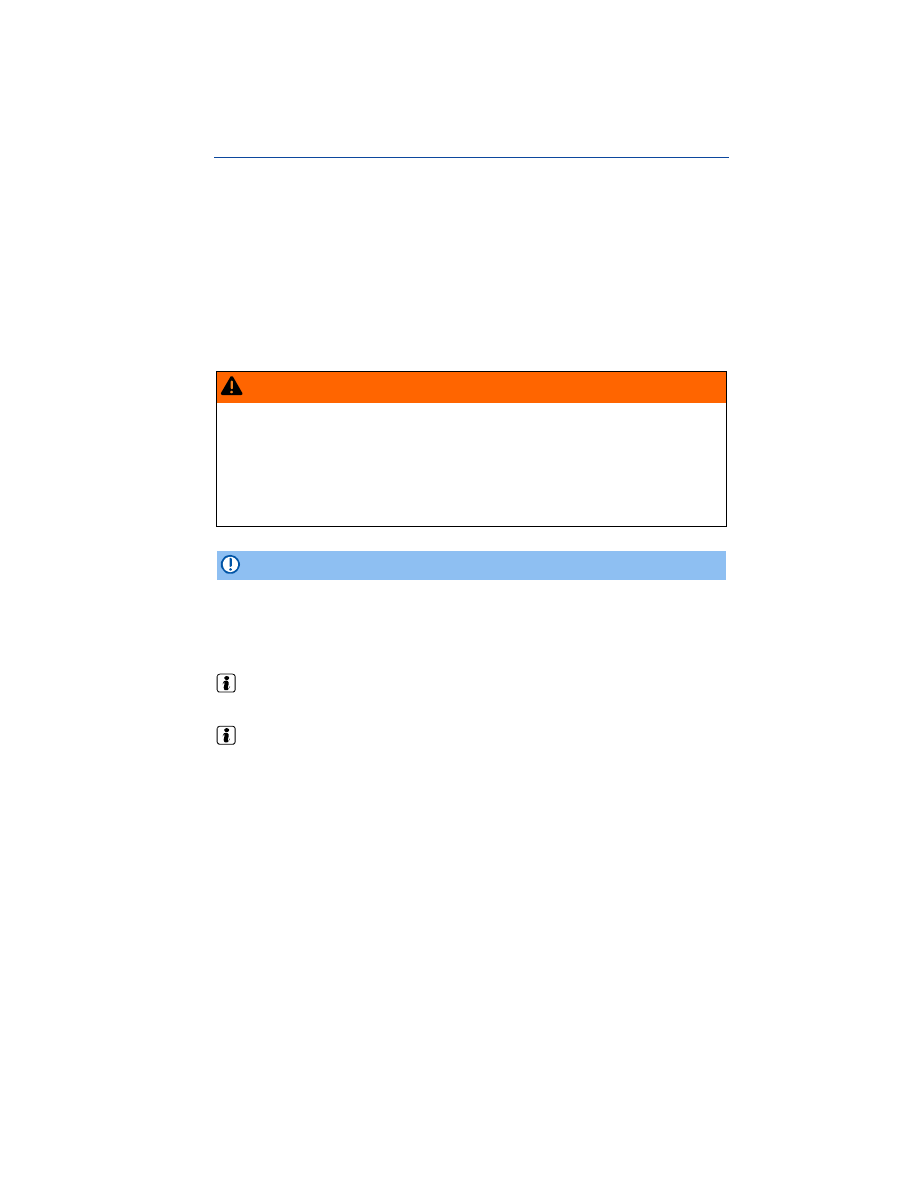
Power sunroof
Introduction
In this section you’ll find information about:
Opening or closing the power sunroof
Opening or closing the sunshade
Power sunroof – convenience opening and closing feature
Pinch protection for the power sunroof and sunshade
Depending on equipment, your vehicle may be equipped with a Panoramic sliding and tilting sunroof.
More information:
Infotainment System
Power locking system
Emergency closing and opening
WARNING
Improper use of the power sunroof can result in serious personal injury.
Always make sure that no one is in the way of the power sunroof when it is closing.
Always take the key with you when you leave the vehicle.
Never leave children or disabled persons in the vehicle – particularly if they have access
to the vehicle key. Unsupervised use of the remote control vehicle key makes it possible to
lock the vehicle, start the engine, turn on the ignition and operate the sunroof.
You can still open or close the power sunroof for several minutes after you switch off the
ignition, as long as the driver or front passenger door has not been opened.
NOTICE
To help prevent damage, remove ice and snow from the sunroof before opening or tilting it
in winter weather.
Always close the sunroof before leaving the vehicle or if it begins raining. If the sunroof is
open or tilted, rain could enter the vehicle interior and cause extensive damage to the electrical
system. This could result in further vehicle damage.
Remove leaves and other objects from the sunroof guiderails regularly either by hand or using a
vacuum cleaner.
If the power sunroof malfunctions, pinch protection may not function properly. See an authorized
Volkswagen dealer or an authorized Volkswagen Service Facility.
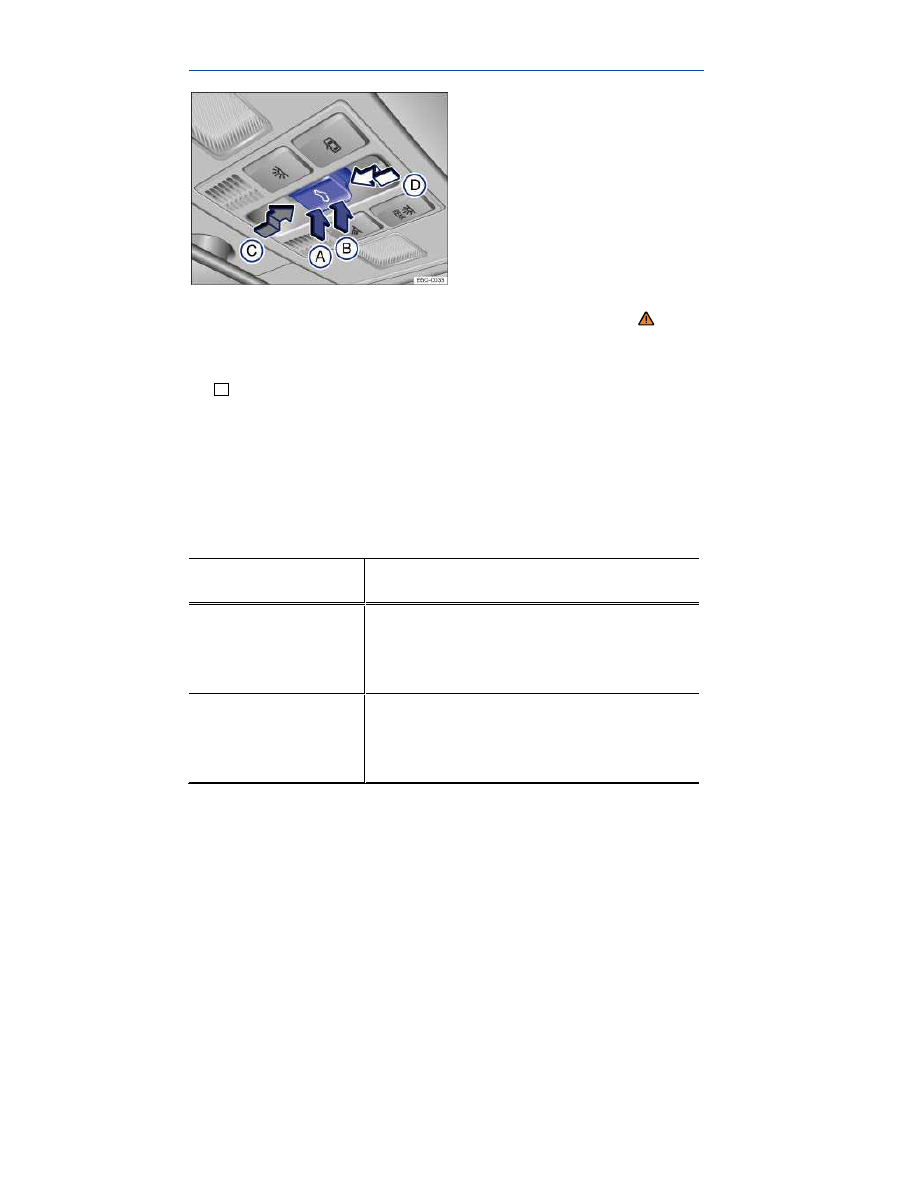
Opening or closing the power sunroof
Fig. 32 In the headliner: Power sunroof switch.
Please first read and note the introductory information and heed the WARNINGS
You must switch on the ignition to operate the power sunroof. After switching off the ignition, you can
still open or close the power sunroof for several minutes as long as the driver or front passenger door
has not been opened.
The
switch
⇒
fig. 32
has 2 detents for each switch position (
(A)
,
(B)
,
(C)
, and
(D)
), which are de-
scribed in the following table.
Press the switch to the first detent to completely or partially tilt, open, or close the sunroof. Press the
switch briefly to the second detent to activate the one-touch feature (automatic operation). Press the
switch again to stop the one-touch feature.
The power sunshade automatically opens with the sunroof if it is closed when the power sunroof
opens, or if the sunroof opens farther than the current sunshade position
⇒ Opening or closing the
sunshade. The sunshade does not close automatically with the sunroof, and it can only be fully closed
when the power sunroof is closed.
Tilting, opening, and closing the power sunroof
Function
Action
⇒
fig. 32
Tilt the power sunroof:
Press the rear area of the switch
(B)
to the first
detent.
Briefly press the switch to the second detent to
activate the one-touch feature.
Close the tilted sunroof:
Press the front area of the switch
(A)
to the first
detent.
Briefly press the switch to the second detent to
activate the one-touch feature.
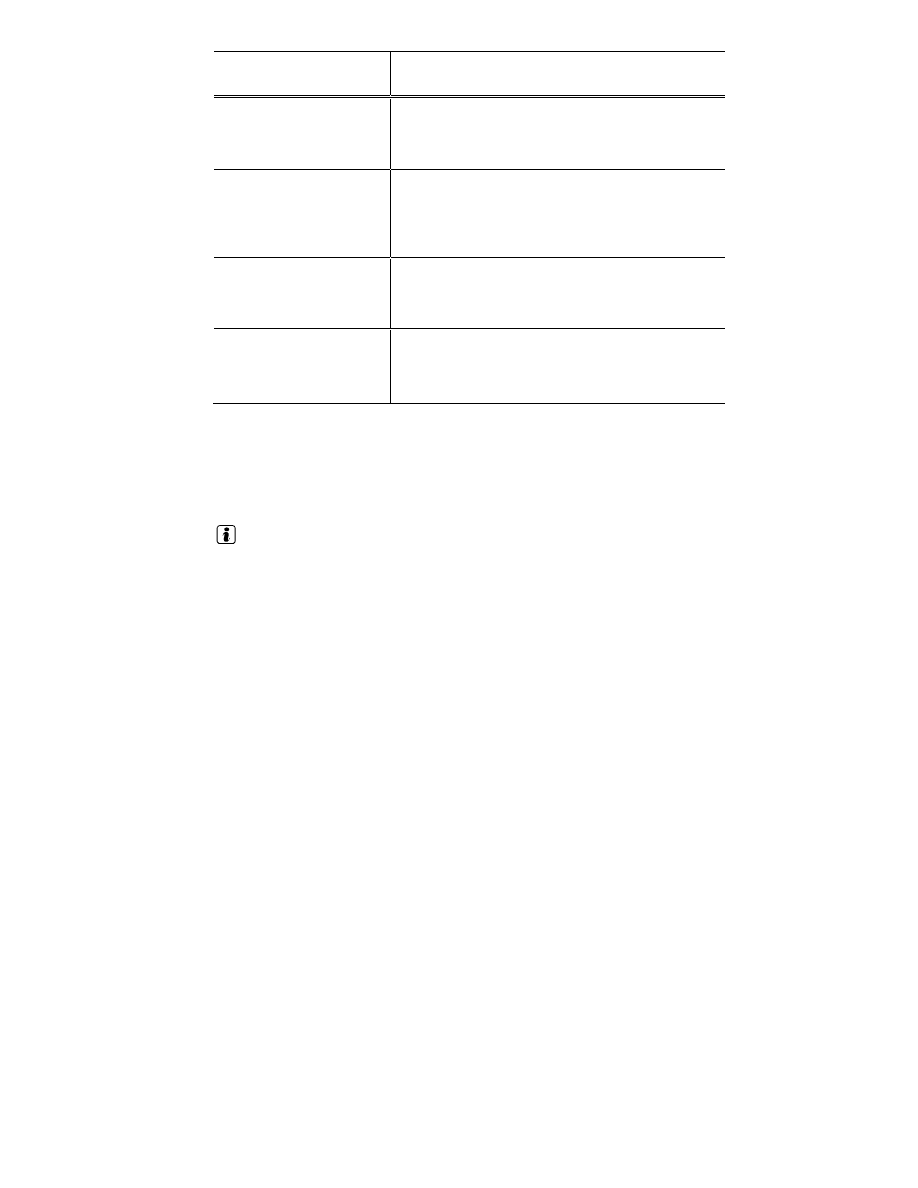
Function
Action
⇒
fig. 32
Stop the one-touch fea-
ture during tilt-
ing/closing:
Press the button again at position
(A)
or
(B)
.
Open the power sun-
roof:
Press the switch rearward
(C)
to the first detent.
Briefly press the switch to the second detent to
open the roof to the comfort position with the
one-touch feature.
Close the power sun-
roof:
Press the switch forward
(D)
to the first detent.
Briefly press the switch to the second detent to
activate the one-touch feature.
Stop the one-touch fea-
ture during open-
ing/closing:
Press the switch again at
(C)
or
(D)
.
Emergency closing of the power sunroof
If your power sunroof will not close properly, do not try to close it yourself, doing so can cause serious
and expensive damage that will not be covered by any Volkswagen Limited Warranty. Special
knowledge and tools are required to close the power sunroof if it will not close on its own. To help
prevent damage to the sunroof, have an authorized Volkswagen dealer or an authorized Volkswagen
Service Facility help you close and repair the power sunroof.
The comfort position provides sufficient ventilation without loud wind noise.

Opening or closing the sunshade
Fig. 33 In the headliner: Buttons for the power sunshade.
Please first read and note the introductory information and heed the WARNINGS
The power sunshade functions when the ignition is switched on.
When the power sunroof is fully tilted, the sunshade automatically moves to the ventilation position.
The sunshade also remains in the ventilation position when the power sunroof is closed.
Buttons
⇒
fig. 33
(1)
and
(2)
have 2 detents.
Press the button to the first detent to completely or partially open or close the sunshade. Press the
button briefly to the second detent to activate the one-touch feature (automatic opening or closing).
Press the button again to stop the one-touch feature.
Function
Action
⇒
fig. 33
Open the sunshade:
Push the button
(1)
to the first detent.
One-touch feature: Push the button
(1)
briefly to the second detent to open com-
pletely.
Close the sunshade:
Push the button
(2)
to the first detent.
One-touch feature: Push the button
(2)
briefly to the second detent to close com-
pletely.
Stop the one-touch feature for
the opening or closing proce-
dure:
Press button
(1)
or
(2)
again.
You can still use the sunshade for several minutes after the ignition is switched off as long as the
driver or passenger door has not been opened.

When the power sunroof is open, the power sunshade can only be closed up to the front edge of
the glass roof.
Power sunroof – convenience opening and closing feature
Please first read and note the introductory information and heed the WARNINGS
Convenience opening and closing
The convenience opening and closing feature lets you open and close the windows and the power
sunroof when the ignition is switched off:
From inside the vehicle: Push down and hold the switch for the driver window until all windows and
the sunroof open.
Vehicles with Keyless Access: Hold your finger on the lock sensor surface on the outside of the
door handle for a few seconds until the windows and power sunroof close
⇒ Unlocking or locking the
vehicle with Keyless Access.
On appropriately equipped vehicles, a variety of settings related to window operation can be made
and adjusted in the Infotainment system by pressing the
button followed by the
and Open and
close function keys
⇒ Menu and system settings (SETUP).
Pinch protection for the power sunroof and sunshade
Please first read and note the introductory information and heed the WARNINGS
Pinch protection can help reduce the risk of pinching injuries when closing the power sunroof or sun-
shade
⇒ . If the power sunroof closing meets resistance or there is something in the way, the
power sunroof or sunshade opens again immediately.
Check why the power sunroof or sunshade did not close.
Try to close the power sunroof or sunshade again.
If the power sunroof or sunshade still cannot close, the power sunroof or sunshade will stop where
the resistance is located. The power sunroof or sunshade will close the next time without pinch protec-
tion.
Closing the power sunroof or sunshade without pinch protection
Power sunroof: Press the
button
⇒
fig. 32
within about 5 seconds after the sunroof or has
stopped and hold it in the direction of the arrow
(D)
at the second detent until the power sunroof closes
completely.
Power sunshade: Within about 5 seconds after the sunshade has stopped, press and hold button
⇒
fig. 33
(2)
until the power sunshade closes completely.
The power sunroof or sunshade will now close without pinch protection!
If the power sunroof or sunshade still will not close, please see an authorized Volkswagen dealer
or an authorized Volkswagen Service Facility.

WARNING
Without pinch protection, the power sunroof or sunshade will close with enough force to
cause serious personal injury.
Always be careful when closing the power sunroof or sunshade.
Always make sure that no one is in the way when overriding the pinch protection to close
the power sunroof or sunshade!
Pinch protection cannot prevent fingers or other parts of the body from being pressed
against the edge of the roof; injuries may result.
Pinch protection is also active during convenience closing of the windows and the power sunroof
⇒ Power sunroof – convenience opening and closing feature.
If the power sunroof malfunctions, pinch protection may not function properly. See an authorized
Volkswagen dealer or an authorized Volkswagen Service Facility for assistance.
Adjusting the seating position
Introduction
In this section you’ll find information about:
Examples of improper seating positions
Proper seating position
Manual controls on the driver and front passenger seats
Electrical controls on the driver and front passenger seats
Adjusting the front and rear head restraints
Removing and reinstalling the front head restraints
Removing and reinstalling the rear head restraints
Adjusting the steering wheel position
Center armrest
Number of seats
The vehicle has a total of 5 seating positions: 2 in front and 3 in the rear. Each seating position has a
safety belt.
More information:
Infotainment system
Seat functions
Safety belts
Airbag system
Child safety and child restraints
WARNING
Improper seating positions increase the risk of severe or fatal injuries in a crash or other
accidents, especially when the airbag deploys.
All occupants must sit properly and be properly restrained at all times.
Never let more people ride in the vehicle than there are seating positions with safety belts
available.
Always secure children in the vehicle with an approved and suitable restraint system ap-
propriate for their age, weight, and height
⇒Child safety and child restraints, ⇒ Airbag sys-
tem.
Always keep your feet on the floor in front of the seat. Never rest them on the seat, in-
strument panel, out of the window, etc. The airbag system and safety belt will not be able to
protect you properly and can even increase the risk of injury in a crash.
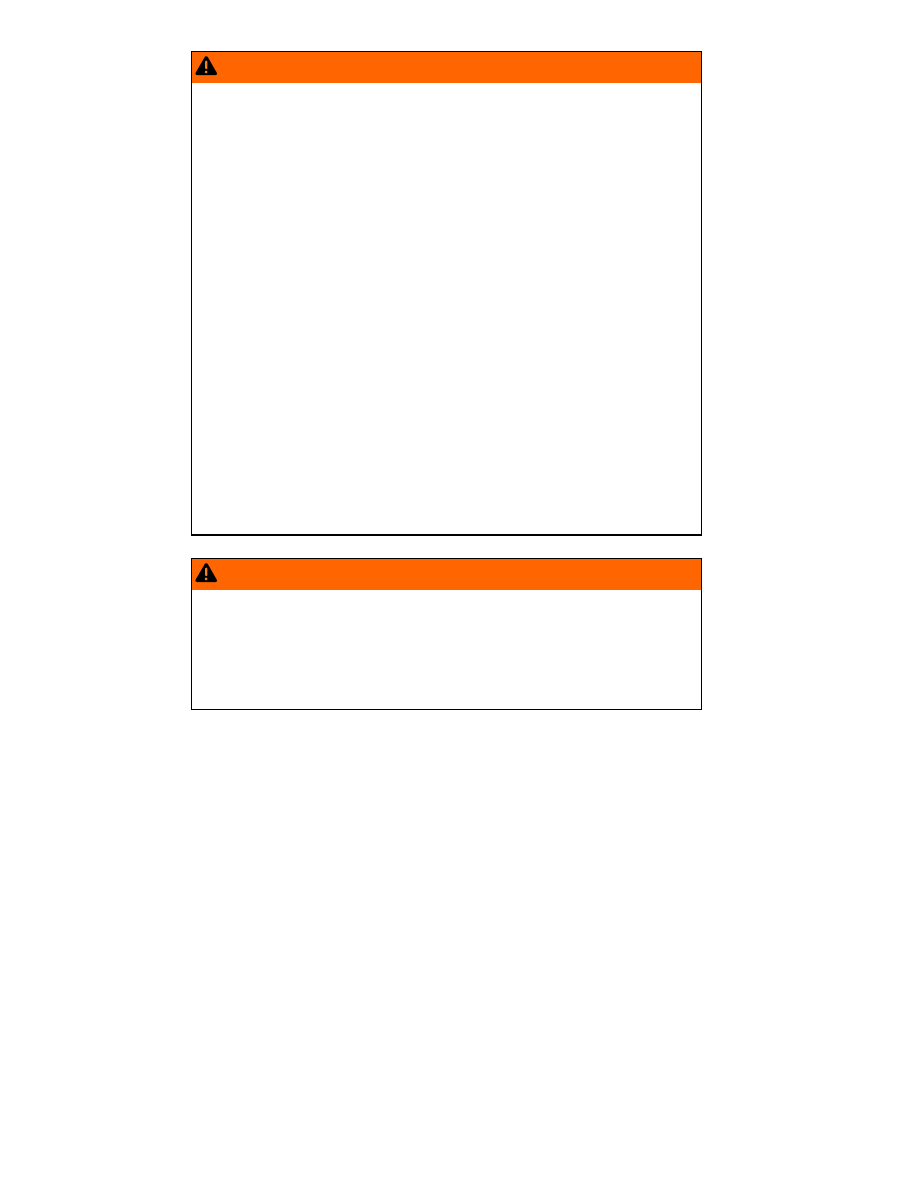
WARNING
Always adjust seat, safety belts, and head restraints properly before driving and make sure
that all passengers are properly restrained.
Push the passenger seat as far back as possible. Always be sure that there are at least
10 inches (25 cm) between the front passenger's breastbone and the instrument panel.
Always adjust the driver's seat and the steering wheel so that there are at least 10 inches
(25 cm) between your breastbone and the steering wheel.
Adjust the driver's seat so that you can easily push the pedals all the way to the floor
while keeping your knee(s) slightly bent.
If these requirements cannot be met for physical reasons, contact an authorized
Volkswagen dealer or an authorized Volkswagen Service Facility to see whether adaptive
equipment is available.
Always hold the steering wheel on the outside of the steering wheel rim with your hands
at the 9 o'clock and 3 o'clock positions to help reduce the risk of personal injury if the driv-
er's airbag inflates.
Never hold the steering wheel at the 12 o'clock position or with your hands at other places
inside the steering wheel rim or on the steering wheel hub. Holding the steering wheel the
wrong way can cause serious injuries to the hands, arms, and head if the driver's airbag in-
flates.
Pointing the steering wheel toward your face decreases the ability of the driver's airbag to
help protect you in a collision.
Never drive with backrests reclined or tilted back farther than necessary to drive comfort-
ably. The farther back the backrests are tilted, the greater the risk of injury caused by incor-
rect positioning of the safety belts and improper seating position.
Never drive with the front seat passenger backrest tilted forward. If the front airbag de-
ploys, the front backrest can be forced backward and injure passengers on the rear seat.
Sit as far back as possible from the steering wheel and the instrument panel.
Always sit upright with your back against the backrest with the front seats properly ad-
justed. Never lean against or place any part of your body too close to the area where the air-
bags are located.
Rear seat passengers who are not properly seated and restrained are more likely to be
seriously injured in a crash.
WARNING
Improper adjustment of the seats can cause accidents and severe injuries.
Never adjust the seats while the vehicle is moving. Your seat may move unexpectedly and
you could lose control of the vehicle. In addition, you will not be in the correct seating posi-
tion while adjusting the seats.
Adjust the front seat height, angle and longitudinal direction only if the seat adjustment
area is clear.
The adjustment of the front seats must not be restricted by things in the footwell in front
or behind the seats.

WARNING
Some kinds of cigarette lighters can be lit unintentionally, or crushed causing a fire that can
result in serious burns and vehicle damage.
Always make sure that there are no lighters in the seat tracks or near other moving parts
before adjusting the seats.
Before closing a storage compartment, always make sure that no cigarette lighter can be
activated, crushed, or otherwise damaged.
Never leave a cigarette lighter in a storage compartment, on the instrument panel, or in
other places in the vehicle. Heat buildup in the passenger and luggage compartment of a
parked vehicle can result in temperatures in the vehicle that are much higher than the outside
temperatures, particularly in summer. High temperatures could cause the cigarette lighter to
catch fire.
Examples of improper seating positions
Please first read and note the introductory information and heed the WARNINGS
Not wearing or improperly fastening safety belts increases the risk of severe or fatal injuries. Safety
belts can work only when they are properly positioned on the body. An improper seating position
significantly impairs the protection provided by safety belts. This can cause severe or even fatal inju-
ries. Improper seating positions also increase the risk of serious injury or death when an airbag de-
ploys and strikes an occupant who is not in the proper seating position. The driver is responsible for all
passengers and especially children riding in the vehicle.
The following are only some examples of seating positions that will increase the risk of serious injury
or death.
Therefore, whenever the vehicle is moving:
Never stand up in the vehicle.
Never stand on the seats.
Never kneel on the seats.
Never ride with the seat backrest reclined.
Never lean up against the instrument panel.
Never lie down on the rear seat.
Never sit on the edge of the seat.
Never sit sideways.
Never lean out the window.
Never put your feet out the window.
Never put feet on the instrument panel.
Never rest your feet on the seat cushion or back of the seat.
Never ride in the footwell.
Never sit or stand on an armrest.
Never ride without your safety belt properly fastened.
Never ride in the luggage compartment.
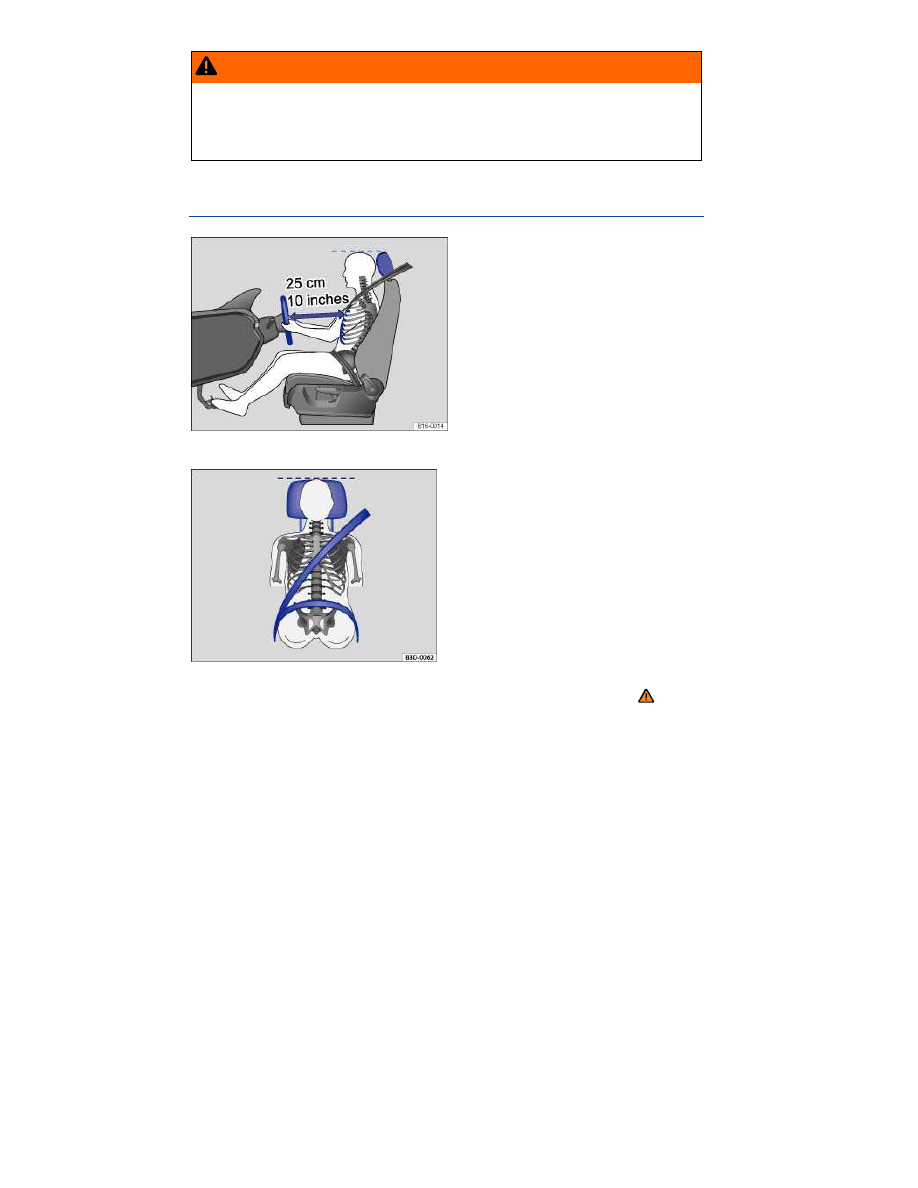
WARNING
Contact with parts of the vehicle interior can cause serious personal injury in a crash.
Always make sure that all vehicle occupants stay in a proper seating position and are
properly restrained whenever the vehicle is moving.
Improper seating positions increase the risk of serious and fatal injury, especially when an
airbag deploys and strikes a passenger in an improper seating position.
Proper seating position
Fig. 34 The driver should never sit closer than 10 inches (25 cm) of the steering wheel.
Fig. 35 Proper safety belt positioning and head restraint adjustment.
Please first read and note the introductory information and heed the WARNINGS
The following describes the proper seating positions for the driver and passengers.
If you have a physical impairment or condition that prevents you from sitting properly on the driver seat
with the safety belt properly fastened and reaching the pedals, special modifications to your vehicle
may be necessary. Only the proper seating position ensures optimum protection by the safety belt and
airbag.
Contact your authorized Volkswagen dealer or authorized Volkswagen Service Facility or call the
Volkswagen Customer CARE Center at 1-800-822-8987 for information about possible modifications
to your vehicle.
For your own safety and to reduce injuries in the event of sudden braking maneuvers or accidents,
Volkswagen recommends the following seating positions:
Applies to all vehicle occupants:
Adjust head restraints so that the upper edge of the head restraint is at least at eye level or higher.
Position the back of your head as close as possible to the head restraint
⇒
fig. 34
and
⇒
fig. 35
.
Push the head restraint completely down for short people, even if the top of the head is then below
the upper edge of the head restraint.
Tall people should pull the head restraint all the way up.
Adjust the seat backrest angle to an upright position so that your back is in full contact with it when
the vehicle is moving.
Always keep both feet on the floor and in the footwell whenever the vehicle is moving.
Always adjust and fasten safety belts properly
⇒ Safety belts.
Driver - seat and steering wheel adjustment:
Adjust the steering wheel so that there are at least 10 inches (25 cm) between the steering wheel
and your breast bone
⇒
fig. 34
. When adjusting the proper distance to the steering wheel, grasp the
top of the steering wheel with your elbows slightly bent.
Always hold the steering wheel on the outside of the steering wheel rim with your hands at the
9 o'clock and 3 o'clock positions to help reduce the risk of personal injury if the driver's airbag inflates.
Never hold the steering wheel at the 12 o'clock position or with your hands at other places inside
the steering wheel rim or on the steering wheel hub. Holding the steering wheel the wrong way can
cause serious injuries to the hands, arms, and head if the driver's airbag inflates.
Adjust the steering wheel so that the steering wheel cover points at your chest and not at your
face. Pointing the steering wheel toward your face decreases the ability of the driver's airbag to help
protect you in a collision.
Adjust the driver's seat so that you can easily push the pedals all the way to the floor while keeping
your knee(s) slightly bent.
Adjust the seat height so that the top point of the steering wheel can be reached.
Always keep both feet in the footwell so that you are in control of the vehicle at all times.
Passenger - front seat adjustment:
Push the passenger seat as far back as possible in order to ensure optimum protection if the
airbag is deployed.

Manual controls on the driver and front passenger seats
Fig. 36 Driver seat: Manual seat adjustment controls.
Please first read and note the introductory information and heed the WARNINGS
The controls on the front passenger seat mirror those on the driver seat.
The illustration and information in this section describes all possible seat controls. The number of
controls may vary depending on the version of the seat.
There may be manual and electrical controls on the same seat.
fig. 36
Function
Action
(1)
Adjust the lumbar sup-
port
Push the lever forward or pull it back-
ward.
(2)
Adjust the backrest an-
gle.
Lean forward and turn the adjuster
wheel forward or backward.
If the vehicle has an electrical control
for adjusting the backrest angle, see
⇒
fig. 37
(2)
.
(3)
Adjust the seat height.
Pull the lever up or push it down.
(4)
Move the front seat for-
ward or back.
Pull the lever up and move the front
seat. The front seat must lock in place
after the lever is released!

Нет комментариевНе стесняйтесь поделиться с нами вашим ценным мнением.
Текст